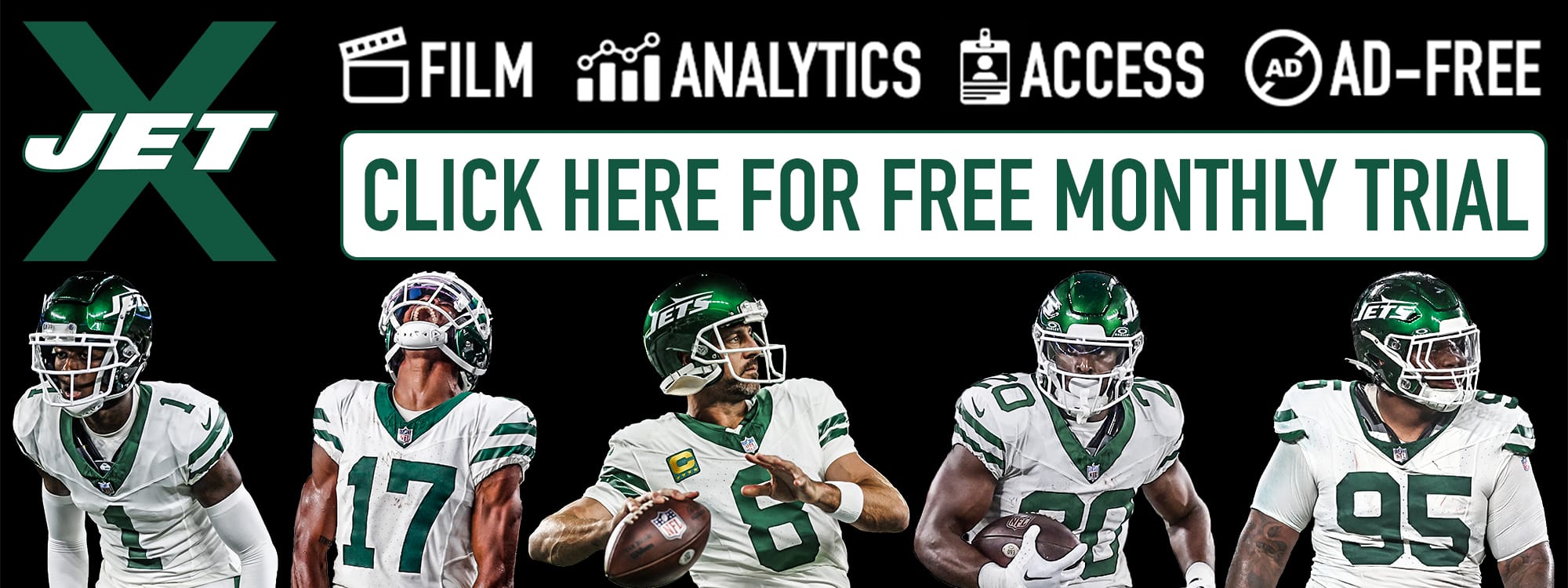New York Jets QB Zach Wilson boasts an otherworldly analytical resume, showcasing proficiency in almost every facet of the position in 2020.
Positives
Proficiency in all-encompassing advanced metrics
Let’s start out with the positives of Zach Wilson’s statistical profile – strap yourself in, because there are a lot of them.
Wilson put up stupendous box score numbers in 2020, completing 247 of 336 passes for 3,692 yards, 33 touchdowns, and three interceptions. That’s an awesome line, but sometimes the box score numbers do not tell the correct story, mainly due to their lack of context. This is why advanced statistics exist; to add context, giving us a truer representation of a player’s impact and performance quality.
Wilson led the nation in Pro Football Focus’ passing grade (95.5), placed third in passing EPA (estimated points added) with a mark of +79.6, and ranked fourth in ESPN’s total QBR (88.6). He and Mac Jones were the only quarterbacks to rank top-four in all three metrics – and Jones played on an offense that had five players (excluding Jones himself) drafted in the top-40 of this year’s draft.
To see Wilson’s box score extravagance backed up by the contextualized numbers is a big confidence-booster in the legitimacy of his production.
Three-level excellence
Showing off a complete all-around game, Wilson threw the ball effectively at all three levels.
Wilson’s deep game was phenomenal. On throws that traveled 20+ yards downfield, he posted the best PFF passing grade in the FBS (99.9). Wilson completed 35 of 56 deep passes for 1,286 yards, 12 touchdowns, and two interceptions. His adjusted completion percentage (accounting for drops) of 67.9% on deep passes ranked second in the country behind Feleipe Franks (68.0%), an undrafted free agent signee of the Falcons.
One concern regarding Wilson’s deep game is the amount of time he needed to get those throws off. Wilson averaged 3.43 seconds from snap-to-throw on his deep attempts in 2020, the fourth-longest duration in the country.
That can work in the NFL, but it generally takes either superb talent or a great offensive line. In 2020, the longest-developing deep throwers were Cam Newton (3.79 seconds), Josh Allen (3.68), Patrick Mahomes (3.50), Russell Wilson (3.45), and Lamar Jackson (3.36). Newton and Jackson played behind elite offensive lines. Allen, Mahomes, and Russell Wilson are immensely talented on-the-move throwers who can extend plays and deliver accurately when on the move or off-platform – which sounds a lot like Zach Wilson’s game.
The intermediate range will be important in Mike LaFleur‘s offense if he takes after his San Francisco days, as 49ers quarterback Jimmy Garoppolo ranked top-8 in the percentage of his passes that were thrown in the intermediate range in each of the past two seasons.
Although he was not quite as dangerous in this area as in the deep range, Wilson was still great in the intermediate range. On passes thrown 10-19 yards downfield, Wilson completed 69 of 100 passes for 1,132 yards, six touchdowns, and one interception. On these throws, Wilson ranked fourth in the nation in passing grade (93.9) and 10th in adjusted completion percentage (72.0%).
Wilson can run the short game, too. On short passes (0-9 yards downfield), Wilson posted the nation’s sixth-best passing grade (82.9) and completed 101 of 119 passes for 897 yards, nine touchdowns, and zero interceptions. His adjusted completion percentage of 88.2% on these throws ranked 11th.
Wilson did not pump up his numbers through screen passes nearly as much as some of his peers in the 2021 draft class. Wilson averaged 26.5 passing yards per game on screen passes, which ranked at the 62nd percentile in the nation. Comparatively, Trevor Lawrence led the country with 68.6 yards per game on screens while Mac Jones placed at the 90th percentile with 45.5 yards per game.
Play action passing
In addition to the intermediate game, another aspect of the 49ers offense that LaFleur will likely carry over is a heavy reliance on play action. Garoppolo ranked top-10 in play action frequency in each of the past two seasons, including fourth in his 2019 Super Bowl season (31.9% of dropbacks).
Wilson has shown he deliver off of play action. On play action attempts in 2020, Wilson completed 89 of 123 passes for 1,548 yards, 20 touchdowns (tops in the FBS), and zero interceptions.
Although Wilson thrived on play action throws, it’s not as if he relied upon it and failed to succeed without the beneficial effects of a play fake. He led the nation with an average of 10.0 yards per attempt on non-play action attempts.
Quick passing
Wilson is known for making many of his biggest plays from enormous pockets or while on the move, but he was actually fantastic as a quick thrower, too.
On throws that were released less than 2.5 seconds after the snap, Wilson completed 133 of 161 attempts for 1,516 yards, 15 touchdowns, and one interception, ranking fourth in the nation in yards per attempt (9.4), fifth in passer rating (134.4), and seventh in adjusted completion percentage (87.5%).
Ball security
Wilson cared for the football like it was his own child in 2020. Over 393 dropbacks, he tossed just three interceptions and had only three fumbles (none lost).
Additionally, Pro Football Focus tracks a stat called “turnover-worthy plays” that looks to exclude non-faulty turnovers (like tipped interceptions) and include lucky non-turnovers (like dropped interceptions, and Wilson even thrived in this area. Wilson was knocked with four turnover-worthy plays, representing 1.0% of his dropbacks, the lowest rate in the FBS among quarterbacks with at least 200 dropbacks.
Was Wilson’s schedule really that much easier than anything we’ve seen before?
Did Wilson play against a relatively light slate of opposing defenses when compared to powerhouse-program quarterbacks like Trevor Lawrence, Justin Fields, and Mac Jones? Yes. But would Wilson be the first quarterback to succeed after playing against soft defenses in college? No.
First off, it has to be understood that a quarterback’s conference does not necessarily dictate the quality of his schedule. Take Patrick Mahomes, for example. He played in the Big 12, where defense doesn’t really exist. Sure, the Big 12 is a Power 5 conference and Texas Tech is a far more well-known program than BYU, but if we’re just looking at the defensive side of the ball, quarterbacks who play in that conference can sometimes have it just as easy as quarterbacks at mid-major schools like BYU.
Here is a look at a comparison between the defenses that Wilson faced in 2020 and the ones that Mahomes faced in 2016. Shown is each team’s FBS-wide ranking in Football Outsiders’ Defensive FEI, a measure of defensive efficiency that is adjusted for strength of schedule.
Wilson’s schedule really wasn’t that much of a cakewalk, featuring a handful of teams that played great defense (even when adjusted for opponent quality) in 2020. Meanwhile, Mahomes’ 2016 schedule shows that even a team from a power conference can luck into a schedule that is loaded with soft defenses.
Baker Mayfield and Kyler Murray also hail from the defensively-challenged Big 12 and appear to be on their way to becoming successful starting quarterbacks in the NFL. It’s completely plausible for quarterbacks to beat up on weak competition and succeed at the next level if their performance on tape backs up their dominant production – which Wilson’s does.
It’s also not as if every star quarterback in the league is from a Power 5 school. Josh Allen, Carson Wentz, Steve McNair, Daunte Culpepper, Rich Gannon, Joe Flacco, Derek Carr, Ben Roethlisberger, Phil Simms, Brett Favre, Tony Romo – the list of successful passers who got to the NFL by stomping on lighter competition goes on and on.
Under pressure passing
Wilson was rarely pressured in 2020, which is a bit of a concern. He took pressure on only 21.6% of his dropbacks, eighth-lowest among qualified FBS quarterbacks.
However, even if those instances were infrequent, Wilson did throw the ball fairly well when he faced pressure. His PFF passing grade of 74.1 on pressured passes ranked eighth-best in the nation, while his passer rating of 98.5 ranked 12th.
Wilson did see his accuracy dip quite a bit as he ranked 55th (out of 140) with an adjusted completion percentage of 61.5% when under pressure, but that’s partially due to his aggressiveness under pressure, as he ranked 38th with an average-depth-of-target of 13.8 yards on pressured passes. His best attribute under pressure was his ball security; Wilson was tagged with zero turnover-worthy plays when under pressure. Wilson’s total of 62 pressured pass attempts without a turnover-worthy play led the nation.
Rushing production
Taking out sacks (which are counted by the NCAA as rush attempts), Wilson ran the ball 66 times for 353 yards and 10 touchdowns in 2020, averaging 5.5 attempts for 29.4 yards and 0.8 touchdowns per game. Most of those rushes were drawn-up – 50 were designed and 16 were scrambles on passing plays – so Wilson has shown he is capable of keeping the ball on option plays and making something happen. Wilson had 14 rushes for 10+ yards.
Concerns
Support
The Cougars had an outstanding support group around Wilson in 2020. As a team, BYU earned the nation’s eighth-best pass blocking grade at PFF (80.2) and second-best receiving grade (91.8).
Of course, Wilson maximized those weapons about as well as you could ask him to, but it is definitely worth noting that his squad was loaded with talent. Wilson had two offensive teammates drafted this year – offensive tackle Brady Christensen (#70, Panthers) and wide receiver Dax Milne (#258, Washington). That’s a huge leap for BYU after having only one offensive player drafted in the previous 11 drafts (RB Jamaal Williams in 2017).
Time will tell whether it was Wilson who put the BYU offense on the map or the other way around.
Pre-2020 production
There is almost nothing not to like about Wilson’s 2020 season from a production standpoint. He was excellent in just about every measurable facet of the position.
The question marks with Wilson arise when we look at what he put on his track record before 2020.

















